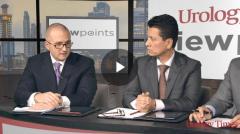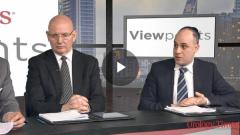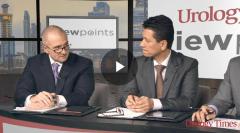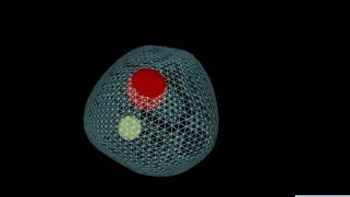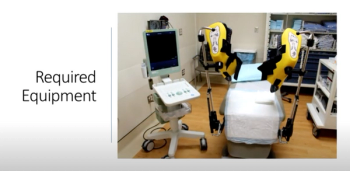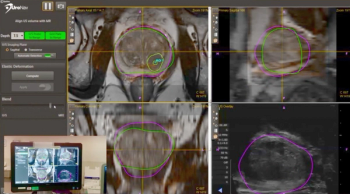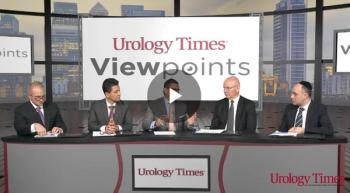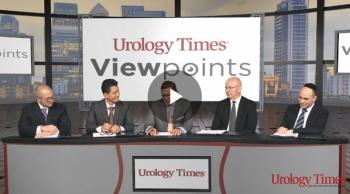
Key Data for the Treatment of mCSPC
Episodes in this series

[Transcript]
Raoul Concepcion, MD, FACS: That was a really nice discussion about current issues we’re facing with ADT [androgen deprivation therapy]. Again, I think most of us fundamentally believe, looking back at the seminal work of Charles Huggins and Clarence Hodges, that androgen deprivation therapy with the lowering of testosterone continues to be foundational. We’re going to talk a little more about that and why that’s confusing to some patients, especially once they come into this castration-resistant realm.
But let’s go to this next, because it seems to be gaining a lot of interest: is this patient of metastatic castration-sensitive prostate cancer? Obviously, these are patients who, in my thinking, can get here 2 different ways. They’re either the patient who has been definitively treated with radiation therapy-whether that’s external beam, brachy, or combination-and then lost to follow-up and, lo and behold, they show up, whether it’s in an emergency department, urologist, medical oncologist, and they have widespread metastatic disease. Or I think what has happened clearly over the past 5 years, because of the whole argument and discussion about PSA prostate-specific antigen and early detection, are these patients who are showing up with de novo metastatic disease having never seen a urologist or had a biopsy, and all of a sudden, boom, they show up in pain, and they have widespread metastatic disease.
Historically, the procedure has always been to do a biopsy, and if this biopsy is positive and they have metastases, go ahead and start them on ADT and see what happens. As we all know, over the past few years, we’ve had multiple trials that have led to the approval of the addition of other agents with ADT. Dr Garcia, walk us through the key registry trials that are changing the paradigm for the management of these patients?
Jorge Garcia, MD: Thank you, Raoul. Let’s first perhaps review the concept. I think you touched upon that, which is the definition of what we see. As you pointed out, for me, when I see someone with castration-sensitive metastatic prostate cancer, it simply means that either you have never received ADT, meaning you have never been castrated and developed metastatic disease, which were very uncommon in the past. I would argue probably the incidence of de novo metastatic disease after PSA became part of what we do routinely, and for follow-up of prostate cancer was in maybe the single digits in the United States compared with the European region.
If you look, then, at after 2012, I want to dispute the United States Task Preventive Force. Clearly, with the recommendation against PSA screening and prostate cancer screening in 2012, the incidence of prostate cancer patients walking into the office with de novo metastatic disease has substantially increased. I don’t think we have contemporary data to suggest what that number really is, but I would argue, at least based on my practice and what many of us have seen, it is probably going to be in the double digits, maybe 12% to 15%, maybe even mimicking what the Europeans have seen for many years because of the lack of PSA screening.
If a patient walks in the office with de novo metastatic disease, if they have not seen ADT, or androgen deprivation therapy, they’re castration-naïve. If they have seen it with the roughly 3 months or so and they’re already responding to treatment early on, they’re castration sensitive. But those 2 aren’t the same patient population. The other patient population, and you referred to it earlier, are those men who have received local definitive therapy for their prostate cancer. For whatever reason were not progressed biochemically, perhaps waiting until they developed metastatic disease. Then basically they walk into the office with metastatic prostate cancer.
When you think about those patient populations, the standard of care has drastically changed, at least for me, since 2013. That is when we released the ECOG data, called the CHAARTED data, that basically addressed a very simple question: if we do docetaxel-based chemotherapy up front in that setting rather than wait until men become castration resistant, who will live the longest, period.
It is important to actually home in on the definition of who those patients were. This is a bit more complex, but actually we’re talking about 2 different patient populations: those who are called low volume and those who are called high-volume disease. I tell my patients that right now volume is important, and intensification of therapy is needed. In the CHAARTED data, all comers had high- and low-volume disease, although the bulk of the patients on the CHAARTED disease were high-volume disease. The bottom line is that data demonstrated unequivocally that across all comers in that trial, men who received ADT and docetaxel-based chemotherapy, specifically 6 cycles of docetaxel given every 3 weeks-standard fashion, 75 mg/m2-had a superior survival compared with those men who only received ADT.
If you split the makeup of those patients, which was prestratified of the entry criteria, we recognize that the patients who benefited the most were those patients with high-volume disease, and the hazard ratio, which is the relative risk reduction in mortality, was almost 40%. That’s huge, right? We haven’t seen that in prostate cancer. That for me changed the paradigm in the management of our patients.
That was complemented also in the same year with the results from the STAMPEDE data. STAMPEDE is a very complex trial design, which is what we call a multiarm, multistage design where you have a backbone of a treatment-in this case ADT-and you add treatment that may actually complement that ADT. At some point, you can remove them or you can start building based on how the field is changing. They also demonstrate that the addition of docetaxel-based chemotherapy to ADT drastically improves survival. In STAMPEDE, they didn’t at the time divide patients based on volume. It was all comers. Later, they recognized actually that again, patients with both low-volume and high-volume disease benefited from the addition of docetaxel-based therapy. That’s the first pass of the data, and it changed how we practiced.
Then came LATITUDE, which is the French data that Karim Fizazi presented at ASCO [the American Society of Clinical Oncology Annual Meeting] 2 years ago, in 2017, whereby they specifically selected high-volume patients. And the definition they used for high-volume patients was a bit different, and we can talk a little more about what that definition looks like, compared with the American definition. In that data, they demonstrated that the addition of the biosynthesis inhibitor abiraterone acetate, or Zytiga, to ADT or ADT and placebo also drastically improved survival for those patients on the combination arm therapy. The hazard ratio was quite similar, almost 0.63, almost a 37% risk reduction in mortality when you add ABI [abiraterone acetate] to that regimen.
STAMPEDE also had an arm with ADT and ABI [abiraterone acetate], yet again they demonstrated that the addition of ABI [abiraterone acetate] in the British data also improved survival drastically. With those 3 big randomized contemporary trials, we know 3 things. We know what is the outcome of someone with metastatic disease, median survival around 44 months. We know what the median survival for someone with high-volume disease is, however one defines high volume in the French and American definitions. That is around 33 months, 34 months for both trials, respectively, and goes up to around 34 for the LATITUDE and 59 for CHAARTED. Hazard ratio unequivocal. That has changed the standard practice for us, and in my opinion what is sad for me to hear is when you look at that data in the United States, almost two-thirds of men with advanced prostate cancer or castration-sensitive or naïve-metastatic disease still are receiving ADT alone, which is, in my opinion, unacceptable.
Raoul Concepcion, MD, FACS: Right, and I would echo that 100%. It is amazing that this data have been out there now. CHAARTED was published 4 or 5 years ago, right, and still less than 50% are getting a secondary therapy despite the data.
Panelists:
- Raoul Concepcion, MD, FACS, Vanderbilt University School of Medicine, Nashville, Tennessee
- Jahan Aghalar, MD, Board-certified Hematologist and Oncologist, New York, New York
- Gordon Brown, MD, Rowan University School of Osteopathic Medicine, Glassboro, New Jersey
- Jorge Garcia, MD, Cleveland Clinic, Cleveland, Ohio; Jonathan Henderson, MD, Regional Urologist, Shreveport, Louisiana
- Paul Sieber, MD, Penn Medicine Lancaster General Hospital, WellSpan Ephrata Community Hospital, Lancaster, Pennsylvania
Newsletter
Stay current with the latest urology news and practice-changing insights — sign up now for the essential updates every urologist needs.


